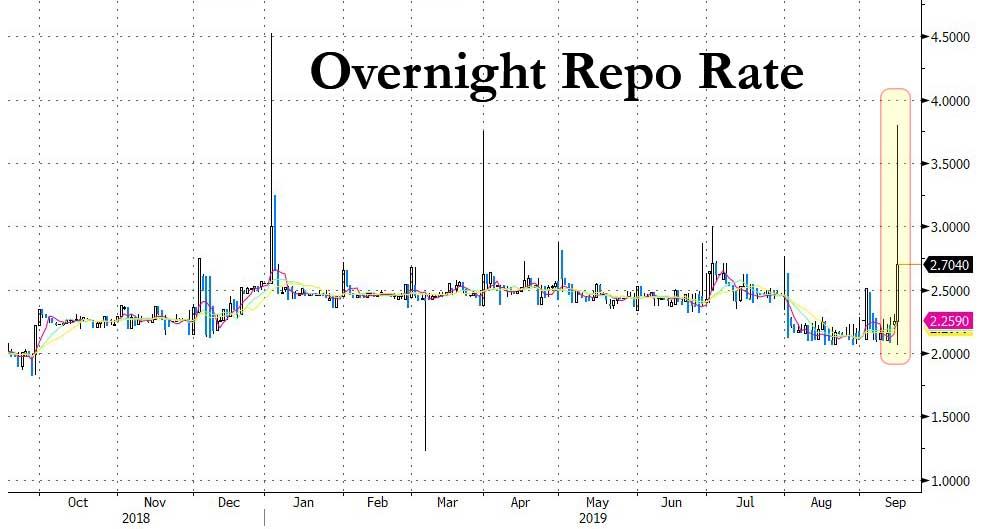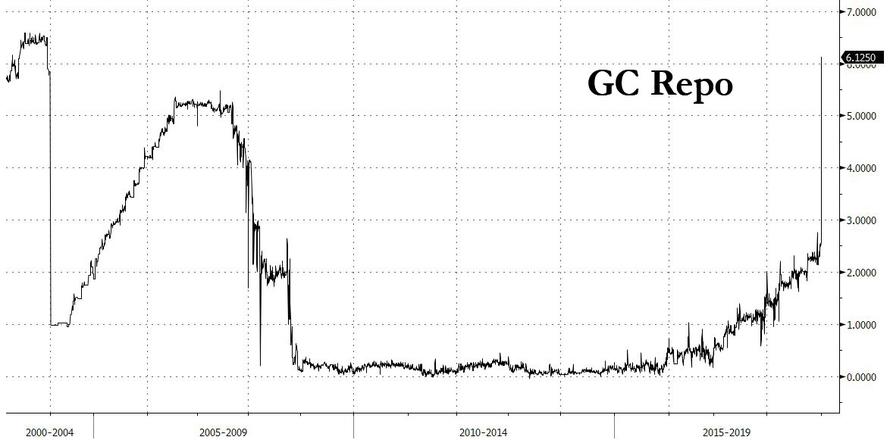Something Just Snapped: Chaos Hits Repo Market As “Dollar Funding Storm” Makes Thunderous Landfall
Late last Friday, we warned that a “dollar funding storm” is set to make landfall in the US amid a series of converging sources of pressure that we said would result in “secured funding markets breaking higher”, among which:
- elevated UST supply,
- bloated dealer balance sheets and year-end regulatory constraints, and
- a banking system near reserve scarcity.
Ironically, it was the rising recession concerns in August – manifesting in the form of an inverted yield curve, cash hiding in repo, and a slow build in UST supply – that kept secured funding pressures at bay. However, as we explicitly noted last Friday, “clear signs of funding pressure could emerge starting next week with sizeable coupon settlements and the mid-September corporate tax date.”
Fast forward to today, i.e. “next week” when the dollar funding storm we warned about has just made thunderous landfall and the overnight general collateral repo rate, an indicator of secured market stress and by extension, dollar funding shortages, soared from Friday’s close of 2.25% to a high of 3.80%, a spike of over 150bps…
… and its biggest one day move since the bizarre GC repo explosion on December 31, 2018.
Commenting on today’s shocking move, BMO rates strategist Jon Hill said that “secured funding markets are clearly not functioning well,” adding that a jump like this, one which is not happening during the traditional quarter end window dressing period, is “bordering on chaos.”
Needless to say, such a move – without a clear catalyst – is a clear indication that plumbing in the overnight funding markets has just snapped, and is badly broken to be trading so far above the effective funds rate. As Bloomberg adds, the spike suggests the next few months could be volatile given the expected increase in Treasury supply, bloated dealer balance sheets, regulatory issues and a banking system where reserves are scarce.
Picking up where he left off in his Friday note, BofA head of rates strategy Mark Cabana said that while “one day is not a big deal, if funding pressures persist, it implies a loss of control of funding markets,” adding what we pointed out previously, namely that “If the market is struggling now, it raises questions about how well the market will handle the fourth-quarter funding squeeze.”
While there was no immediate catalyst, as we explained on Friday, the reason behind Monday’s GC repo explosion is a combination of factors including the settlement of the mid-month Treasury coupon auctions that pushed collateral into the repo market, even as cash is leaving the funding space as corporations have withdrawn cash parked with banks and money-market funds to make their quarterly tax payment.
But the biggest reason for the sudden dollar shortage is that as discussed extensively, following the recent debt ceiling deal, the Treasury is aggressively pushing its cash balance higher while depleting the amount of bank reserves in the system.
The drop-off in reserves and fund outflows is driving up funding rates and is starting to spill into the fed funds market because repo’s attractive yields can draw some lenders away from the unsecured market.
Which again brings us the $64 trillion question: as a reminder, on Friday we concluded by asking rhetorically, “how to determine if the dollar funding squeeze will cause another major risk off episode?” Here, BofA said that as the Fed starts to test these reserve lows, “we expect funding markets to react by showing further Treasury cheapening, widening of FRA-OIS, and narrowing of front-end spreads & SOFR-FF basis.”
However, once the Fed responds by engaging in repo or outright UST purchase operations we expect these markets to move in the opposite direction. We suggest clients continue to trade these themes tactically and consider moving out of UST cheapening positions as fed funds rises towards the IOER +15 to +20 bps level.
We also said that “if the Fed wants to front-run the funding shortage, and aggressively inject liquidity into the system, nothing prevents it from following in the ECB’s footsteps and hint at another round of QE in the near future: not only would that send stocks soaring in the asset bubble’s “Icarus song”, but it would also make Trump happy, if only until it all comes crashing down.”
The problem for the Fed is that following today’s massive move in repo higher, it now appears that the Fed is once again behind the curve, and this time the funding squeeze could have dire consequences for not only the economy but the market, as the broken repo plumbing means that despite $1.4 trillion in excess reserves, one or more banks are suddenly left without liquidity, which as we explained over a month ago in “Forget China, The Fed Has A Much Bigger Problem On Its Hands”, the only alternative Powell may soon have is to restart QE.
Tyler Durden
Mon, 09/16/2019 – 14:15
![]()
Zero Hedge’s mission is to widen the scope of financial, economic and political information available to the professional investing public, to skeptically examine and, where necessary, attack the flaccid institution that financial journalism has become, to liberate oppressed knowledge, to provide analysis uninhibited by political constraint and to facilitate information’s unending quest for freedom. Visit https://www.zerohedge.com


